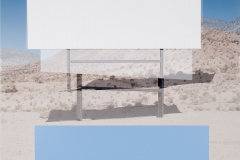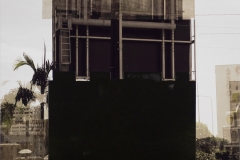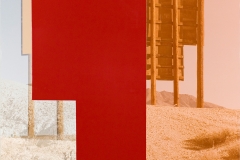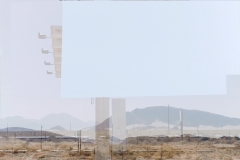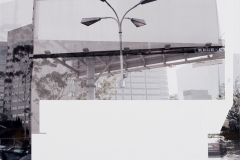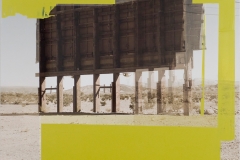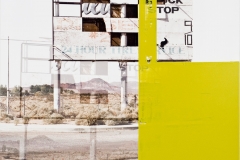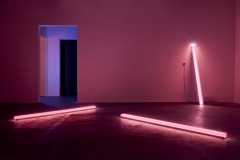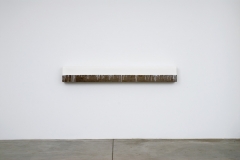An Interview with Johannes Girardoni
Viewing the work of American-based sculptor and installation artist Johannes Girardoni feels like the moment when you realize, after studying semiotics or sending what you thought was a clear e-mail, that all our intended meanings eventually destabilize into base misunderstandings. The idea that you can never say what you mean or control how you’ll be heard makes it easy to give up on the idea of language or creating art. That is, until you realize that the void itself is a source of creative freedom.
Girardoni is fascinating for all the ways he tries to erase, reduce, and distill the world around him: blank billboards he further empties with color overlays, wood blocks covered in pigmented beeswax, “sign-less signs.” His work exists somewhere between a presence and an absence, some intersection between materiality and deconstruction. And because he’s willing to create work that still elicits emotion—not just brain work—he captures something of the real and tangible voids we experience everyday.
Born in Austria, Girardoni grew up in Vienna and immigrated to Southern California in 1982. He studied history and art at Bowdoin College and earned a B.A. in both in 1989. During this time, he also studied at M.I.T. and accepted an invitation as guest artist at M.I.T.ʼs Media Lab. His work has been shown at museums and galleries in the US, Europe, and Asia. In 2008, Feichtner Editions published his 116 page monograph on solo exhibitions in Austria and New York, and in 2011 his light and sound installation, The (Dis)appearance of Everything, was included in the 54th Venice Biennale, Italy. Girardoni now lives and works in Los Angeles.
The Fiddleback: Tell me about your compositional method. How do you find the right balance between the photographs, which often use double exposures, and the parts you reduce and/or subtract with paint?
Johannes Girardoni: At first I was just shooting images of blank billboards wherever I was traveling for projects. I wasn’t doing it with any intention. It was more an act of image collecting, and it wasn’t even exclusive to billboards. About five years ago, I spent a year in Europe. Since much of my work is larger scale and I did not have my regular studio, I needed to continue to make work in a different way. I rented a tiny room and started going over the images I had accumulated over the past years. I was struck by how many billboards I had shot, but they were all empty, or shot from behind, revealing their structure. I’m less interested in photography per se, so I started out by printing the pics on my inkjet printer and manipulating the image, over-painting certain sections. I quickly realized I liked the idea of stacking doubles: I used double exposures of the same image and started working with a double-negation, that is, taking an image of something, in this case a blank billboard and negating that image by over-painting it: a sign-less sign, overpainted. So in answer to the question of the composition, many of the shots are done loosely, simply as an act of visual recording from various perspectives. That sets the base image that is then manipulated digitally, by lifting out layers and physically adding layers of paint. A third photograph of the same billboard that is not actually in the photograph usually determines the painted shape. I use that third image and project it onto the prints to create a positive or negative shape to block out and reveal elements of the underlying images. My decisions there depend on the rest of the imagery and how I can best de-compose it, so that the viewer can still put it back together in their brain. It’s surprising how quickly an image dis-integrates when you take things out, cover things up, or remove sections of layers. I like to set them up in a way that the photograph (the archived light) and the paint (the physical material) come into a relationship in which the viewer has to decipher what’s digital and what’s material, but can still rebuild what he or she is seeing. The viewer completes the piece. This way of image making is entirely opposite of how advertising works. In advertising, the image is meticulously designed for instant, easy uptake. I do the opposite.
The Fiddleback: What inspired you to use advertising billboards for this series?
JG: It’s exactly what I just started talking about in the other question. Advertising is our culture’s contemporary iconography. Hence the title, Exposed Icons. Everything we feel, do, or want, can be traced to advertising. It’s ubiquitous, and while the big billboards I shoot are remnants of advertising’s prior iteration, we can’t ignore the fact that advertising has infiltrated virtual space, where it’s a lot less obvious, and it knows much more about our interests. But let me get back to the sign-less sign. For someone as myself, who isn’t interested in making representational art, I felt the billboard is an appropriate image to acquiesce and explore ideas about the language of signs. I came back from an expedition deep into West Africa a few years back. On my return, I was really cued into our culture’s highly developed visual systems and the pervasiveness of advertising. So I reacted by making this work.
I think that as an artist, it is my responsibility to dissect and confront those things that go on in our culture that are unresolved and changing….
The Fiddleback: The erasure you apply to billboards by masking their utility for communication completely shifts their context and forces us, I’d argue, to focus our attention on the loneliness and beauty of their physical structure. Would you say that reductionism drives your work?
JG: I think that as an artist, it is my responsibility to dissect and confront those things that go on in our culture that are unresolved and changing. Every artist goes about that in their own way, and I find it most effective to keep stripping away at a thing or an idea to expose a simple connection, a basic premise. If it holds up at that level, then I know I am on to something that’s worth pursuing. What really struck me about the billboards is that they are ubiquitous. Whether I am in Eastern Europe outside a desolate country village, in New York City, 500 miles south of Timbuktu in Africa, or driving through the deserts of the American Southwest . . . these places all have one thing in common: Billboards. They articulate differently in every location, some are elaborately built, gigantic structures; others scantily held together signs made of found wood. By focusing on the side that is unseen, I reveal their structure, which is the part that we never look at. These structures are always beautiful, because they are built with such efficiency. Advertising is a driver of commerce and at the core of the culture we are today. The only way I can strip away at that is through my work. And however troubling the underlying ideas of the work, my seduction comes in the form of something beautiful. I think the signs are beautiful. The attractor in my work is always something that I feel is well made, executed as close to perfection as possible—but what those things say about where we are on the cultural spectrum, sometimes conveys a much darker reality.
The Fiddleback: You’ve also worked with light installations and “organic sculptures” composed of wood and paint. Does the medium you use dictate form and content, or do you start with an idea and then try to find the right medium to represent it? Do prefer working in one medium over another?
JG: Right now I find it most effective to work with light and sound. I have a few core ideas that I explore in all of my work. At it’s most basic level, my work is about the relationship of light and material. Historically, that’s what artists have always done. Go back to the Renaissance and we figured out how to represent space and light in the form of a picture as a “window.” Paint was turned into an image of a person, or an image of building; that all changes as art moves into the modern age. The picture plane flattens and we wind up with abstract art, where the painting itself becomes the object and stops representing things outside itself. Move along, and we arrive at an art that was predominantly developed here out west—the Light and Space movement—where perception itself becomes the artwork. In a Turrell for example, you sense yourself seeing. But things don’t end here. I concern myself with where we are right now. And right now, we are at a point in our culture where technology and human perception are about to merge. Digital and virtual systems are colliding with our natural selves. This is the new reality. In answer to your question about the relationship between the idea and the medium, I have always explored that same idea—of light and material—but my new series directly address these current concerns in my choices of material. The photos go into these very questions. The photos are digital, which means that they are no longer even real photographs. They are archives of light, but are virtual in that the information is rearticulated through algorithms. It’s no longer simply captured light. But to come to the point, I deconstruct these by digital means and then I over-paint them with physical paint, which I think of as flat sculpture. So here is the convergence of digital information and material paint. For me the digital/analog architecture of the over-painted photograph creates a new reality that is at the core of what we are faced with. We have to figure out where digital ends and material begins. That’s one of the main points of these works.
The Fiddleback: What are you working on now?
JG: All of these questions of light and material take on deeper and more relevant positions when one starts to think about our convergence of our natural selves and technology. Think about the iPhone, and how our social behavior has changed since its inception, or how we read a landscape differently as a result of the navigation we now use. This is just the beginning of the human—technology interface. The new reality is that we are no longer the only ones sensing. Our perception, which has reigned supreme as long as human history, is now being challenged by technological systems of our own making. There is an infrastructure in place that senses us and our behavior. No matter where you stand on that development, it is the new reality. My latest projects deal with those questions—again in the context of light and material. Only in these new works, light remains light, but the material is sound. I have been working on mapping the visible spectrum and transposing it on the audible spectrum, converting light waves to sound wavers. Through a process of Spectro-sonic Refrequencing I have come up with a way to make light audible with the use of sensors. My two newest works are based on those ideas. Metaspace V2 is a contained immersive light and sound sculpture, which you can enter. The sculpture generates light and converts it to sound with the use of sensors creating a virtual feedback loop between artwork and viewer. ChromaSonic Field—Blue Green, the other sculpture, is a resin and light installation, which also converts light to sound. In this work, viewers walk through the installation and the sound that is generated by the light is modulated by the presence of the viewer. The light situation in that installation, however, appears to change, but it does not. It’s just the result of your perception making you think it is changing. The exhibition just opened last week at Nye+Brown in Los Angeles. Both projects are ambitious in scale and idea. I have been working on them for the better part of a year, and it’s been a push to the edge of the envelope of getting them realized. Physically and conceptually.
All images courtesy of Johannes Girardoni Studio, Inc.

